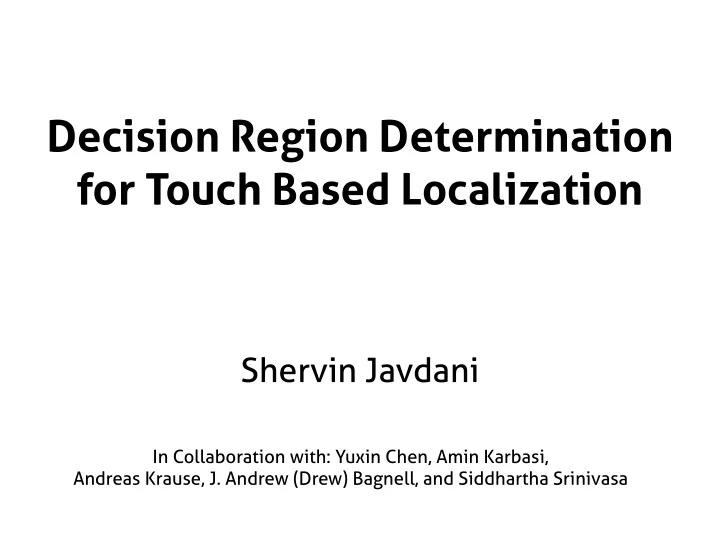

Decision Region Determination for Touch Based Localization Shervin Javdani In Collaboration with: Yuxin Chen, Amin Karbasi, Andreas Krause, J. Andrew (Drew) Bagnell, and Siddhartha Srinivasa
Guarded Moves Are E ff ective Objective: Generate sequence of moves automatically
Task: Open the Microwave
Hypotheses Possible Object Locations
Tests Information Gathering Actions
Localize Object Hypotheses Tests Goal: Determine object location (with fewest tests) S. Javdani, M. Klingensmith, J. A. D. Bagnell, N. Pollard, and S. Srinivasa. Efficient touch based localization through submodularity. In IEEE ICRA , 2013.
The task should a ff ect how information is gathered
Decisions Task-Performing Actions • Actions to accomplish task • Corresponding hypotheses
Localize Object Hypotheses Tests Goal: Determine object location (with fewest tests)
Determine Successful Decision Hypotheses Tests Decisions Goal: Determine which decision will succeed (with fewest tests)
Decision Region Hypothesis Test … … … … … … Decisions a ff ect termination condition and optimization criteria
Framework is General Hypotheses Tests Decision Regions Movie Risky Choice Application Bird Conservation Recommendation Selection Hypothesis Cause of nest failure Target Movie Theory Pair of lottery Test Monitoring Action Pair of Movies choices Decision Conservation Recommendation Theory adoption
Optimization Bounds C ( π ) = E [number tests] NP-hard to optimize NP-hard to approximate s.t. C ( π ) ≤ C ( π ∗ ) · o (ln N ) [1] Key Insight: Formulate as adaptive submodular maximization C ( π G ) ≤ ( α ln N + 1) C ( π ∗ )
Method Overview • Our Problem: Overlapping decision regions • Known algorithm: Disjoint regions • Extend known algorithm to solve our problem
Edge Cutting (EC 2 ) [2] • Edges between hypotheses in di ff erent decision regions • Edge cut if any hypothesis it connects removed Key Properties: 1. All edges cut i ff all hypotheses in one decision region 2. Adaptive submodular
EC 21 EC 22 DiRECt EC 23
EC 21 EC 22 DiRECt EC 23
EC 21 All hypotheses in one region i ff All edges in one EC 2 instance cut EC 22 DiRECt EC 23
Combine EC 2 Instances Y • Combine instances with noisy-OR 1 − (1 − f i ) • Objective maximized i ff one EC2 instance complete • Still adaptive submodular • Performance bound and computation time scale with number of regions Can we use fewer EC 2 instances?
EC 21 EC 22 DiRECt EC 23
EC 21 EC 22 DiRECt EC 23
EC 21 EC 22 DiRECt EC 23
DiRECt HEC ˆ 2 k ln( N ) + 1 k ln( N ) + 1 Approximation ˆ O ( kN ) k ) O ( N Runtime 5 4.5 Query complexity GBS 4 EC2 EC2 − DRD GBS − DRD 3.5 VoI 3 DiRECt HEC 2.5 0 200 400 600 800 1000 Number of Tests
Di ff erences • Non-Adaptive • Adaptive • Motions relative • Motions Globals • Complex Tests • Simple Tests
[1] V. T. Chakaravarthy, V. Pandit, S. Roy, P. Awasthi, and M. Mohania. Decision trees for entity identification: Approximation algorithms and hardness results. In ACM-SIGMOD PODS, 2007. � [2] D. Golovin, A. Krause, and D. Ray. Near-optimal bayesian active learning with noisy observations. In NIPS, 2010. � [3] S. Javdani, Y. Chen, A. Karbasi, A. Krause, D. Bagnell, and S. Srinivasa. Near- optimal bayesian active learning for decision making. In AISTATS , 2014.
Recommend
More recommend